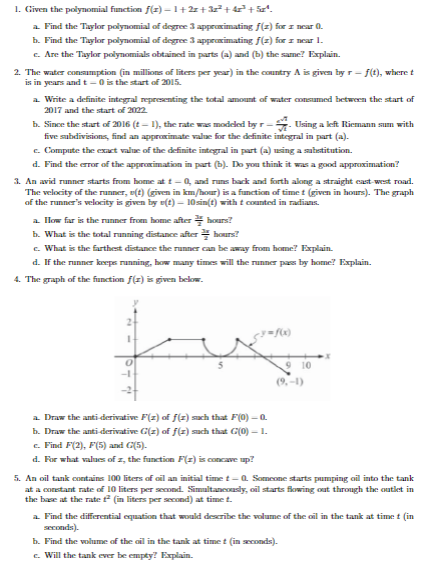1. Given the polynomial function f(z)-1+2x+3x²+4x²³ +5x¹. a. Find the Taylor polynomial of degree 3 approximating f(z) for z near 0. b. Find the Taylor polynomial of degree 3 approximating f(z) for z near 1. e. Are the Taylor polynomials obtained in parts (a) and (b) the same? Explain. 2 The b in millione of t in the f(t) wh
1. Given the polynomial function f(z)-1+2x+3x²+4x²³ +5x¹. a. Find the Taylor polynomial of degree 3 approximating f(z) for z near 0. b. Find the Taylor polynomial of degree 3 approximating f(z) for z near 1. e. Are the Taylor polynomials obtained in parts (a) and (b) the same? Explain. 2 The b in millione of t in the f(t) wh
Linear Algebra: A Modern Introduction
4th Edition
ISBN:9781285463247
Author:David Poole
Publisher:David Poole
Chapter6: Vector Spaces
Section6.3: Change Of Basis
Problem 17EQ
Related questions
Question
100%
Please answer them with details and explaination! Thank you so much!

Transcribed Image Text:1. Given the polynomial function f(2)=1+2x+3x²+42²³² + 5x¹.
a. Find the Taylor polynomial of degree 3 approximating f(z) for near 0.
b. Find the Taylor polynomial of degree 3 approximating f(z) for z near 1.
c. Are the Taylor polynomials obtained in parts (a) and (b) the same? Explain.
2. The water consumption (in millions of liters per year) in the country A is given by r-f(t), where t
in years and t-0 is the start of 2015.
is
a. Write a definite integral representing the total amount of water consumed between the start of
2017 and the start of 2022.
b. Since the start of 2016 (t-1), the rate was modeled by r-Using a left Riemann sum with
five subdivisions, find an approximate value for the definite integral in part (a).
e. Compute the exact value of the definite integral in part (a) using a substitution.
d. Find the error of the approximation in part (b). Do you think it was a good approximation?
3. An avid runner starts from home at t-0, and runs back and forth along a straight east-west road.
The velocity of the runner, v(t) (given in km/hour) is a function of time t (given in hours). The graph
of the runner's velocity is given by e(t)- 10sin(t) with t counted in radians.
a. How far is the runner from home afterhours?
b. What is the total running distance afterhours?
e. What is the farthest distance the runner can be away from home? Explain.
d. If the runner keeps running, how many times will the runner pass by home? Explain.
4. The graph of the function f(z) is given below.
fux
a. Draw the anti-derivative F(2) of f(1) such that F(0) — 0
b. Draw the anti-derivative G(z) of f(z) such that G(0) - 1.
c. Find F(2), F(5) and G(5).
d. For what values of z, the function F(z) is concave up?
5. An oil tank contains 100 liters of oil an initial time t-Q. Someone starts pumping oil into the tank
at a constant rate of 10 liters per second. Simultaneously, oil starts flowing out through the outlet in
the base at the rate ² (in liters per second) at time t.
a. Find the differential equation that would describe the volume of the oil in the tank at time t (in
seconds).
b. Find the volume of the oil in the tank at timet (in seconds).
c. Will the tank ever be empty? Explain.
9 10
Expert Solution
This question has been solved!
Explore an expertly crafted, step-by-step solution for a thorough understanding of key concepts.
Step by step
Solved in 6 steps with 6 images

Recommended textbooks for you

Linear Algebra: A Modern Introduction
Algebra
ISBN:
9781285463247
Author:
David Poole
Publisher:
Cengage Learning

Algebra for College Students
Algebra
ISBN:
9781285195780
Author:
Jerome E. Kaufmann, Karen L. Schwitters
Publisher:
Cengage Learning

Algebra & Trigonometry with Analytic Geometry
Algebra
ISBN:
9781133382119
Author:
Swokowski
Publisher:
Cengage

Linear Algebra: A Modern Introduction
Algebra
ISBN:
9781285463247
Author:
David Poole
Publisher:
Cengage Learning

Algebra for College Students
Algebra
ISBN:
9781285195780
Author:
Jerome E. Kaufmann, Karen L. Schwitters
Publisher:
Cengage Learning

Algebra & Trigonometry with Analytic Geometry
Algebra
ISBN:
9781133382119
Author:
Swokowski
Publisher:
Cengage

College Algebra
Algebra
ISBN:
9781305115545
Author:
James Stewart, Lothar Redlin, Saleem Watson
Publisher:
Cengage Learning